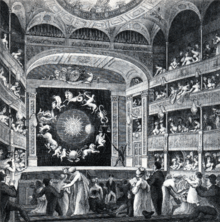Eidouranion

Proscenium of the English Opera House, Strand, 21 March 1817, with Walker's exhibition of the Eidouranion.
An Eidouranion is a kind of orrery that combined mechanical movement with a method of back projection. Its invention is attributed to Adam Walker who in the 1780s[1] built one measuring 27 feet in diameter. He used it to accompany his lectures on astronomy. It is an ancestor of planetarium projectors.
It is known that Adam Walker held lectures featuring the Eidouranium at the Royal Theatre in London in the 1780s[2] and the London Lyceum.[3]
The word "eidouranion" derives from the Greek compound "eid + ouranos".[4] The combining elements are "eidos", which means "what is seen, shape, form",[5] and "ouranos", which was the name of the god of the heavens.[6] Thus, the combined form means "shaped like the heavens" or "formed like the heavens".
References
- ↑ "Glossary of the Magic Lantern Society".
- ↑ Lankford, John. History of astronomy: an encyclopedia. p. 405.
- ↑ During, Simon. Modern Enchantments: The Cultural Power of Secular Magic. p. 219.
- ↑ Webster's New International Dictionary (Second ed.). The Riverside Press, Cambridge, MA USA: G. & C. Merriam Co. 1950.
- ↑ "eid". The Cognatarium. Retrieved January 28, 2015.
- ↑ "Uranus". Encyclopedia Brittannica. Retrieved January 28, 2015.
External links
Further reading
- King, Henry C, and John R. Millburn. Geared to the Stars: The Evolution of Planetariums, Orreries, and Astronomical Clocks. Toronto: University of Toronto Press, 1978. Print. [esp. Ch. 19: The Eidouranion and Other Large Transparent Orreries]
This article is issued from Wikipedia - version of the 10/11/2016. The text is available under the Creative Commons Attribution/Share Alike but additional terms may apply for the media files.